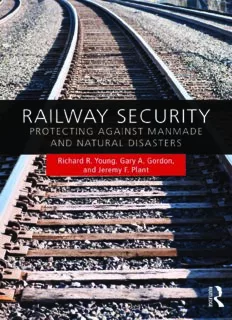
Railway Security : Protecting Against Manmade and Natural Disasters PDF
Preview Railway Security : Protecting Against Manmade and Natural Disasters
Railway Security This book provides an overview and assessment of the security risks, both man- made and natural, facing the railways and rail networks. Railroads face significant threats from disasters, but with situational awareness and coordinated effort these can often be substantially minimized. Transportation assets have always been vulnerable to natural disasters, but in the current environ- ment these assets are also a preferred target of human-caused disruption, espe- cially in the form of terrorism, as the events in many other parts of the world have underscored. Railways are not a homogeneous mode of transportation given their various roles in intercity and commuter passenger movement, as well as being a major portion of the freight ton-miles upon which the U.S. economy is highly dependent. Designed to provide advice for railway owners and first responders, this text discusses how to secure hazardous material transport and how to estab- lish guidelines for rail freight operations and rail passenger operations. The book aims to develop an understanding of the unique operating characteristics of rail- ways, the nature and the range of vulnerabilities, the present means for protecting the infrastructure, and the required public policy initiatives that are prerequisite for developing a comprehensive appreciation of the magnitude of this issue. The book utilizes case studies of transport disasters to illustrate lessons learned and to provide critical insight into preventative measures. This book will be of great interest to students and practitioners of transporta- tion, technology and engineering, and security management. Richard R. Young is Professor of Supply Chain Management at the School of Business Administration, Pennsylvania State University, Harrisburg, USA, and a Fellow of the Chartered Institute of Logistics and Transport. Gary A. Gordon (Lt. Col., USA, Ret.) is Adjunct Faculty at the University of Massachusetts Lowell, USA, and former Assistant Federal Security Director for DHS/TSA, Railroad Specialist for the former ICC, and Assistant Chief Engineer of a Northeast railroad. Jeremy F. Plant is Professor Emeritus of Public Policy and Administration, Pennsylvania State University, Harrisburg, USA. Railway Security Protecting Against Manmade and Natural Disasters Richard R. Young, Gary A. Gordon, and Jeremy F. Plant First published 2018 by Routledge 2 Park Square, Milton Park, Abingdon, Oxon OX14 4RN and by Routledge 711 Third Avenue, New York, NY 10017 Routledge is an imprint of the Taylor & Francis Group, an informa business © 2018 Richard R. Young, Gary A. Gordon, and Jeremy F. Plant The right of Richard R. Young, Gary A. Gordon, and Jeremy F. Plant to be identified as authors of this work has been asserted by them in accordance with sections 77 and 78 of the Copyright, Designs and Patents Act 1988. All rights reserved. No part of this book may be reprinted or reproduced or utilized in any form or by any electronic, mechanical, or other means, now known or hereafter invented, including photocopying and recording, or in any information storage or retrieval system, without permission in writing from the publishers. Trademark notice: Product or corporate names may be trademarks or registered trademarks, and are used only for identification and explanation without intent to infringe. British Library Cataloguing-in-Publication Data A catalogue record for this book is available from the British Library Library of Congress Cataloging-in-Publication Data Names: Young, Richard R., 1946– author. | Gordon, Gary A., author. | Plant, Jeremy F., 1945– author. Title: Railway security : protecting against manmade and natural disasters / Richard R. Young, Gary A. Gordon, and Jeremy F. Plant. Description: Abington, Oxon ; New York, NY : Routledge, 2017. | Includes bibliographical references and index. Identifiers: LCCN 2017006850 | ISBN 9781420080643 (hardback : alk. paper) | ISBN 9781315155296 (ebook) Subjects: LCSH: Railroad accidents—Prevention. | Railroads—Security measures. | Terrorism—Prevention. | Emergency management. Classification: LCC HE1779 .Y66 2017 | DDC 363.12/2—dc23 LC record available at https://lccn.loc.gov/2017006850 ISBN: 978-1-4200-8064-3 (hbk) ISBN: 978-1-315-15529-6 (ebk) Typeset in Times New Roman by Apex CoVantage, LLC We gratefully dedicate this book to our wives – Mary, Bobbie, and Susan – for the patience that they had for us during the long period of research and writing that went into this vol- ume. They left us to the solitude of our respective studies and endured overhearing many long conference calls. We could not have done it without their encouragement and support. Contents List of figures ix List of tables x Foreword James M. Loy xi Preface xiii Abbreviations xv Glossary xxi 1 Introduction to railroad security 1 2 U.S. railroad systems overview 21 3 Securing the infrastructure 37 4 Railroad policing efforts 58 5 Securing rail freight operations I: Securing the logistics chain (including intermodal) 74 The nature of private railcar fleets in North America 89 Customs-Trade Partnership Against Terrorism and the rail link in the chain of custody 91 6 Securing rail freight operations II: Hazardous materials 95 7 Securing rail freight operations III: Hazmat and the specific case of crude oil and ethanol 109 Oil spill in Oregon 118 8 Commuter passenger rail 122 Passenger rail attacks in India 136 viii Contents 9 Intercity passenger rail 139 10 Emergency or incident response, operations, and security 154 11 Protecting rail infrastructure: Where do we go from here? 174 Index 185 Figures 5.1 SCOR Model applied to railroad freight markets 75 5.2 SCOR Model with flows illustrated 76 5.3 Vulnerabilities and threats 87 6.1 Ten major chemical-producing U.S. states 96 7.1 Annual rail carloads of crude and ethanol (thousands) 113 7.2 Orders for new tank cars (thousands) 113 8.1 Major commuter rail lines 124 8.2 Disaster responses 127 9.1 U.S. intercity passenger rail routes 145 10.1 Typical NOAA/NWS five-day track 155 10.2 FEMA preparedness cycle 160
Description: